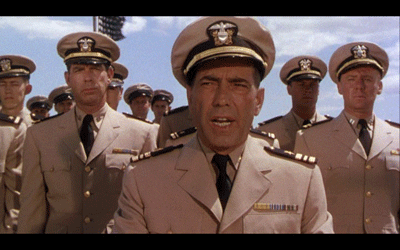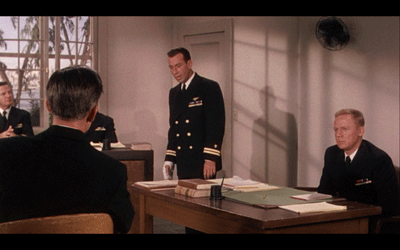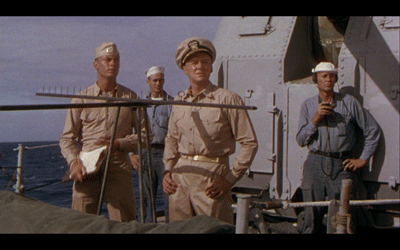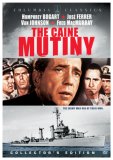| Reviews & Columns |
|
Reviews DVD TV on DVD Blu-ray 4K UHD International DVDs In Theaters Reviews by Studio Video Games Features Collector Series DVDs Easter Egg Database Interviews DVD Talk Radio Feature Articles Columns Anime Talk DVD Savant Horror DVDs The M.O.D. Squad Art House HD Talk Silent DVD
|
DVD Talk Forum |
|
|
| Resources |
|
DVD Price Search Customer Service #'s RCE Info Links |
|
Columns
|
|
|
Caine Mutiny - Collector's Edition, The
THE MOVIE:

The classic 1954 film The Caine Mutiny is many things. It's a war picture, a courtroom drama, political allegory, and the golden hour for many wonderful studio players at the tail end of the Hollywood studio system. Produced by Stanley Kramer and directed by Edward Dmytryk from a Pulitzer-winning novel by Herman Wouk (The Winds of War), The Caine Mutiny manages to have all kinds of cake and eat it, too.
As the fictional story goes, the young and untested Navy ensign Willis Keith (Robert Francis) is assigned to the crew of the Caine, a dilapidated mine sweeper that seems to do just about everything but sweep up mines. He is not so pleased to be part of an operation that is falling apart. On his initial tour of the boat, he overhears another sailor saying that it makes no sense to scrape the rust off the hull, as that's the only thing keeping the water out. His first captain (Warner Anderson) is a salty sort who knows his lot in life while also accepting he's got more practical wisdom than the men who put him there. He let's the Caine run as it does because it works, and it keeps the men happy. The crew sees themselves as sailors in exile. You don't go to the Caine by choice, you end up there.
To get along in this environment, Keith accepts the tutelage of the two lead officers on the ship: the stand-up Lt. Maryk (Van Johnson) and the cynical, sarcastic novelist Lt. Keefer (Fred MacMurray). When a new captain is assigned to take over the boat, Keith is excited by the new emphasis on regulation and order, but the older men aren't as eager to embrace the new standard. Maryk complies out of an exasperated sense of duty, and Keefer merely accepts because there is nothing else to be done. The new boss, Captain Queeg, is played by Humphrey Bogart, and most people know you're not going to push Humphrey Bogart around easily.
Queeg is a veteran of many North Atlantic battles, but no one really knows why he's been sent down to the Caine. Theories develop as, first in target practice and then in real battle, Queeg shows not just a lack of judgment, but more drastically, a lack of nerve. When he goes off on rants about doing things by the book, he misses the larger picture and causes accidents to happen. When the enemy fire is coming fast and furious, he cuts the Caine's mission short and high-tails it from the scene. In both cases, he crafts elaborate lies to cover his tracks, material that Keefer uses to convince the others that Queeg is a dangerous paranoid. Maryk and Keith both resist the theory, but eventually come around. That's when Keefer introduces article 184 of the Navy code: the article for relieving your commander from his duty.
This intrigue occupies the first two acts of The Caine Mutiny, and it's as riveting as any war film even without the constant presence of guns blazing. Amongst the dissenters, Van Johnson and Fred MacMurray work well together. Maryk has a consistent sense of duty and honor and going against Queeg is a tough decision, one he only takes when he feels he has no other choice. Keefer, on the other hand, doesn't seem to believe in much of anything. Institutions are hollow and men are made of straw--including himself. MacMurray plays up the cynicism, but not without lacing the performance with self-doubt and loathing. As Ensign Keith, Robert Francis bounces between the two, playing what is essentially the central role of The Caine Mutiny. Thankfully, the material overshadows the actor enough that Francis can't drag the production down. Keefer may believe that men are made of straw, but Francis' acting style almost makes a better case for some men being made out of wood.
Two other actors run away with the picture, however. One of them, of course, is Bogart. While his turn as the gold-obsessed Dobbs in Treasure of the Sierra Madre serves as sort of prototype for Queeg, Bogart's crack-up as the captain has much more pathos. We always suspect that Dobbs is weak-willed and greedy, but Queeg isn't so obvious in his psychosis. The captain is a once great man who has been knocked around by war, and he stands firm at first, only losing his footing by degrees. When he does finally shatter, Bogart makes it heartbreaking. This is not an evil man, but one who has lost his way. The actor is sensitive to his character's illness, and it's one of the great icon's most nuanced performances.

The other memorable acting job in The Caine Mutiny comes from José Ferrer, who plays Lt. Barney Greenwald, the lawyer who defends Maryk against charges of mutiny. The final act of the film is the court martial hearing. Greenwald is reluctant to take the case at first, but once he is before the presiding counsel, he chips away at the prosecution to try to expose the truth. This also means chipping away at Queeg. Ferrer approaches the assignment with a quiet confidence. He never asserts himself via histrionics or dramatic gesticulation, but rather wields the power of the text like a precision blade. My memories of first seeing this movie on television when I was a child consist entirely of Ferrer and Bogart going toe to toe, and watching it again now on DVD, these two powerhouses whaling on each other with words is still the best part of The Caine Mutiny.
On its release in 1954, The Caine Mutiny was a big hit. In retrospect, our reading of the film can encompass added meanings related to the political climate of the time. Stanley Kramer was a famously liberal producer, and it's likely that he saw some relation between Queeg and Senator Joseph McCarthy, the paranoid captain struggling to maintain power a scathing portrayal of the leader of America's communist witch hunt. On the other side, Edward Dmytryk, who had directed such progressive films as Crossfire and Christ in Concrete, had been part of the original Hollywood 10 before he decided to become a friendly witness and cooperate with HUAC. We can speculate that maybe he saw a little of himself in Maryk, a man who did what he thought he had to do, and for good or for bad, found himself having to explain his choices. Maryk went against the system, he disrupted the order of things, and there were consequences for it--including possibly selling out a comrade along the way. Somewhere in between is Keefer, the empty intellectual who can only think but not act.
In the end, the lawyer Greenwald plays the conscience of the film. He's the one who recognizes all of the pieces on the chess board and calls them out for the complicity they had in what occurred onboard the Caine. Without him, the case of Queeg vs. crew would appear to be cut-and-dried. After the trial is over, however, he drunkenly brings the hammer down on the self-satisfied victors, raising questions about loyalty, courage, and the true meaning of duty. While my own personal leanings would be to side with the individual against the institution, Greenwald makes a compelling argument about the necessity of men like Queeg, what they are asked to do, and what he and the other men involved were occupied with while Queeg was doing it. Somewhere in the past, a very young Aaron Sorkin must have been sitting in front of his TV taking notes, as one of Jack Nicholson's monologues in A Few Good Men parrots Ferrer's almost note for note. Yet, in The Caine Mutiny, with the full force of history standing behind it, the sentiment has more poignancy, ringing with the clarity of a true belief rather than the quick justifications of self-preservation.

THE DVD
Video:
The Caine Mutiny's 1.85:1 anamorphic widescreen transfer is generally pretty clean. The colors almost have a painterly feel, and the values are rather nice on the largely gray and khaki populated ship. There are occasional stray spots of random color, most notably in chapter 11, when I noted some green flickers on the officers' meeting table. In the same chapter, at approximately minute 58:00, there is a layer shift that freezes up the disc for a second.
Sound:
The original Engish audio and a French language track are mixed in 2.0, and there are also subtitles in both languages. Decent audio. Not exceptional, nothing egregiously wrong, just right.
Extras:
"Inside The Caine Mutiny" is a documentary about the movie featuring three film scholars--Richard Peña, program director of the Film Society of Lincoln Center; filmmaker Ken Bowser; and critic Bob Castle--discussing the history of the picture. It's broken into two parts, each around twenty minutes in length. The first part is about the development and production of The Caine Mutiny, including the history of the book and profiles of Kramer and Dmytryk. The second deals more in specific story elements. I find documentaries about classic films to be far more interesting than contemporary ones, as the passing of time has allowed for perspective and reflection. "Inside The Caine Mutiny" is no different.
(Noir fans take note: When they show a clip from Kramer and Dymtryk's The Sniper as part of "Inside The Caine Mutiny," a note at the bottom informs us that this excellent film about a nihilistic shooter is on its way to DVD soon!)
Two of the scholars from the documentary, Peña and Bowser, have recorded an audio commentary for The Caine Mutiny. Right from the get-go, they start covering much of the same ground we already heard in the featurette, but naturally, they have a lot more time to fill here and get much more specific in their details. The two clearly enjoy the film and enjoy each other's company, so they approach the film with a sort of jovial respect and have fun with it. They offer both their own interpretations as well as background facts, and they make for an entertaining listen. I particularly enjoy their discussions trying to puzzle out the complicated political leanings of the film. The narrative leaves a lot of openings for interpretation.
Also included are three trailers for other movies. Inexplicably, these are for straight-to-DVD action flicks, which don't really seem like the right movies to target for the Caine Mutiny audience.
FINAL THOUGHTS:
The Caine Mutiny is a classic that holds true even fifty years later. The strength of the writing and the insightful performances from many of Hollywood's finest actors keep the drama feeling real even to this day. The tale of a Naval captain who has lost his nerve and the lengths his crew feel forced to go in order to keep their ship afloat raises questions of loyalty and courage that are timeless, ongoing concerns. As long as there are men, there will be conflict, and as long as there is conflict, there will be debates about how men conduct themselves under fire--and stories about them, too. In this genre, The Caine Mutiny sets the standard. Highly Recommended.

Jamie S. Rich is a novelist and comic book writer. He is best known for his collaborations with Joelle Jones, including the hardboiled crime comic book You Have Killed Me, the challenging romance 12 Reasons Why I Love Her, and the 2007 prose novel Have You Seen the Horizon Lately?, for which Jones did the cover. All three were published by Oni Press. His most recent projects include the futuristic romance A Boy and a Girl with Natalie Nourigat; Archer Coe and the Thousand Natural Shocks, a loopy crime tale drawn by Dan Christensen; and the horror miniseries Madame Frankenstein, a collaboration with Megan Levens. Follow Rich's blog at Confessions123.com.
|
| Popular Reviews |
| Sponsored Links |
|
|
| Sponsored Links |
|
|
| Release List | Reviews | Shop | Newsletter | Forum | DVD Giveaways | Blu-Ray | Advertise |
|
Copyright 2024 DVDTalk.com All Rights Reserved. Legal Info, Privacy Policy, Terms of Use,
Manage Preferences,
Your Privacy Choices | |||||||













